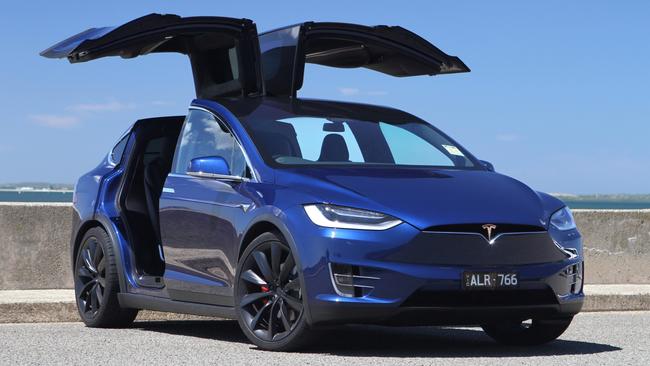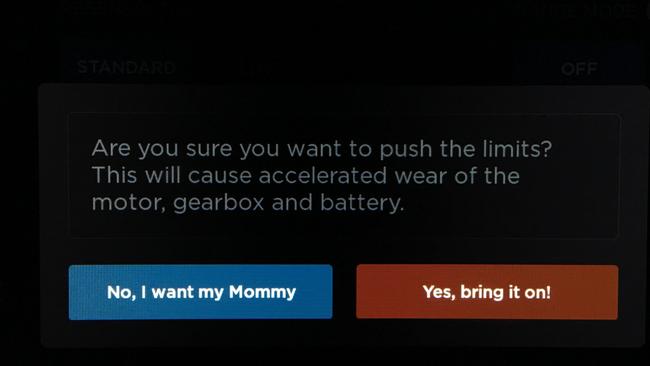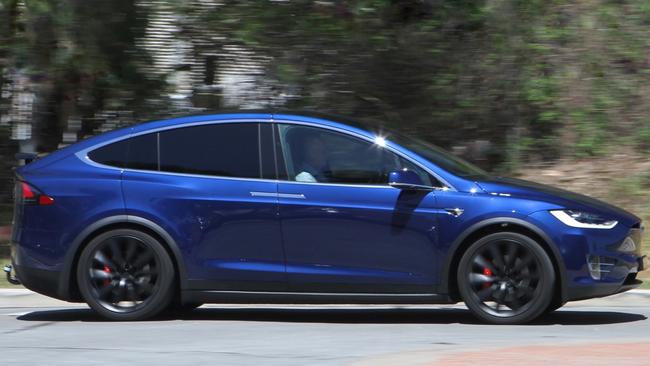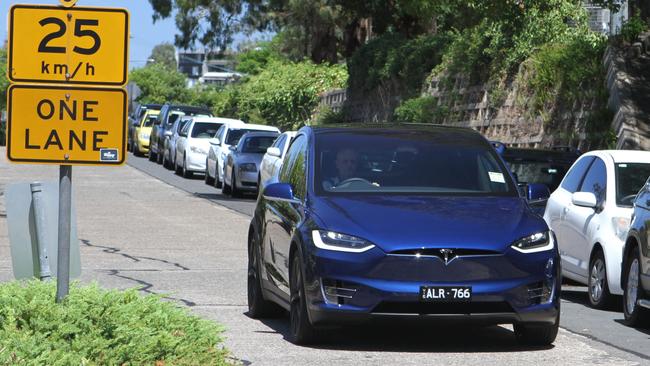Tesla Model X test drive
TESLA’S Model X is like nothing else on the road. It seats seven but accelerates as quickly as a Ferrari. We jumped behind the wheel.
Aliens have landed — Tesla’s new Model X has touched down in Australia.
The futuristic vehicle with its dramatic “falcon wing” doors that open skywards is like nothing else on the road.
For a start it’s the fastest SUV ever built. The family-friendly seven-seater sprints from zero to 100km/h in a claimed 3.1 seconds, quicker than some Ferraris. And the EV has a claimed range of more than 500km, the same as a petrol-powered SUV.
The minute you approach the Model X, it’s clear this is no ordinary car. As you walk up with the key still in your pocket, it opens the driver’s door.

Once you’re inside there’s no need to turn it on or select a gear — simply put your foot on the accelerator and you’re off — like a scalded cat.
The takeoff is so brutal, it should come with a warning label for pregnant women and people with back complaints. You’re shoved hard into the leather seat and there’s a silent, relentless surge of power that’s more like an amusement ride than a conventional car.
And that’s before you select “ludicrous” mode. Tesla is a tech company first and a vehicle maker second, so the Model X has plenty of “geek” appeal.

Push the “Ludicrous” button and it unlocks more power. Hold it down for a few seconds and it unlocks a hidden feature — Tesla calls it an Easter egg — that turns up the wick even more.
You know you’ve unlocked it because the huge, iPad-like centre screen looks like you’ve selected light speed on the Millennium Falcon.
Then you have a choice between two buttons — “I want my mommy” and “bring it on”.
It’s about then you start to wonder if this is the right message to be sending to the driver of a family-focused SUV.

Thankfully, acceleration not the Model X’s only drawcard.
The claimed range of 546km is by far the longest claimed by an electric production car and the company claims it will have the ability to drive itself when future software updates are released.
For now, though, our test car has none of the “autopilot” features that have made headlines — for both the right and, tragically, wrong reasons — overseas.
In the United States authorities have just completed an investigation into the death of a driver whose Tesla crashed while on Autopilot. They found no defect with the system, but Tesla upgraded its software in response to the accident.

All the hardware — cameras, sensors etc — is in place, and customers can order the autopilot option now and receive the software update later. It’s not cheap, though. For those who pay for it upfront — before it’s available — the cost is $7600. Pay later and that cost rises to $9100. Full self-driving is another $4600 upfront or $6100 later. When you consider that self-driving is “pending regulatory approval” you’re taking a bit of a punt.
Elsewhere, the Model X feels relatively normal, aside from the doors of course. At the press of a button they lift up like a bird about to take off. It’s an impressive feature — and they only need 30cm of room to open — but you wonder whether the novelty would wear off after a while.
The centre screen, which debuted on the Model S, is easy to navigate and is linked to Google Maps and Google Earth. The infotainment system is wi-fi enabled and you also get a complimentary Spotify subscription, with free data for four years.

It’s not as practical as other high-end SUVs though. The second row seats don’t fold flat for bigger loads and those doors mean that roofracks aren’t an option.
Third-row seat occupants sit under the glass of the steeply raked tailgate, which could get uncomfortable in summer. The same goes for the front, where there is a huge front windscreen. It might seem like a little thing, but having to pump up the aircon zaps your range and power noticeably.
On the plus side, access to the third row seats is easier than other seven-seaters and you can seat adults in the third row. You also have extra luggage space under the bonnet.
As a driver, the Model X experience is top notch.

Forward vision is good and the suspension glides over all but the sharpest of edges in the road surface. It’s well controlled too, settling quickly after a big bump at speed.
Head for the curves and the Model X continues to impress.
You can still feel the weight of the car under braking, but through the corners it resists that top-heavy lean you get with most big SUVs, thanks to the huge slab of batteries in the floor of the car.
The brakes are strong and the acceleration is expletive-inducing.
Our only gripe was the range, which didn’t get anywhere near Tesla’s claims.
When we picked the car up it had an estimated 487km left. We took it on our normal 150km test loop, which includes an equal split of city traffic, freeway driving and secondary country roads. At the end the range was 222km.

This isn’t unique to electric cars — petrol cars understate their range as well, but the discrepancy was far more pronounced.
After a series of roughly 8-10 “ludicrous” launches and some more city driving, we returned to Tesla head office with 237km on the trip computer and 7km left to empty.
Then there’s the price — our test car was $305,000 on the road, so while it may an enticing option for the rich, it’s hardly going to revolutionise our car buying habits.
That said, it is an exciting glimpse of the future.




